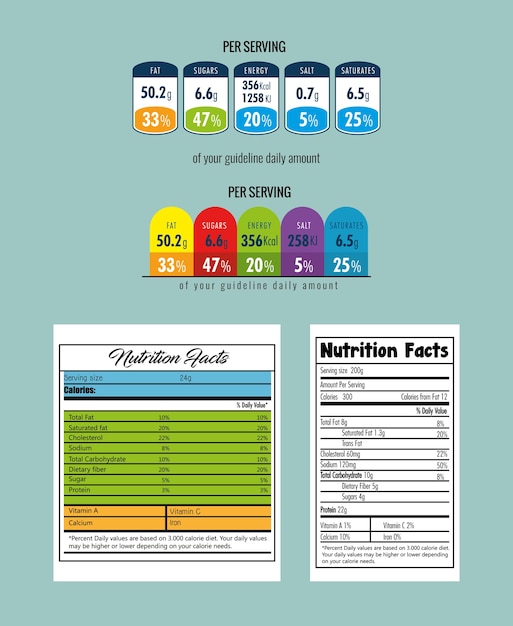Decoding Food Labels: Your Guide to Healthy Choices

Decoding food labels involves understanding key components like serving sizes, nutrients, and ingredients to make informed dietary choices and promote better health.
Decoding food labels: What you need to know to make healthy choices can feel like navigating a complex maze. But with a little know-how, you can easily decipher the information and make smarter decisions for your health. Let’s break down the essentials!
Understanding the Basics of Food Labels
Food labels are designed to provide consumers with essential information about the nutritional content and ingredients of packaged foods. Understanding these labels is crucial for making informed decisions about what you eat. Let’s delve into the basic components that make up a food label.
Key Components of a Nutrition Label
The nutrition label contains several essential components that provide a comprehensive overview of the food’s nutritional profile. These components include serving size, calories, macronutrients, and micronutrients.
Ingredient Lists and What They Tell You
The ingredient list is another critical part of the food label. It lists all the ingredients in the product, in descending order by weight. This means the ingredient that makes up the largest portion of the product is listed first, and so on.

- Check for Added Sugars: Look for terms like high fructose corn syrup, sucrose, and dextrose.
- Be Aware of Artificial Additives: Identify artificial colors, flavors, and preservatives.
- Consider Allergens: Ensure the product is safe for those with food allergies or sensitivities.
Understanding the basics of food labels empowers you to make better nutritional choices. By carefully examining the information provided, you can select foods that align with your dietary goals and health needs.
Serving Size vs. Portion Size: What’s the Difference?
Understanding the difference between serving size and portion size is fundamental to accurately interpreting food labels and managing your calorie intake. Many people often confuse these terms, which can lead to miscalculations and unintended dietary consequences. Let’s clarify the distinction.
Defining Serving Size
The serving size is a standardized amount of food listed on the nutrition label. It is determined by the manufacturer and is intended to represent the amount of food that is typically consumed in one sitting.
How Portion Size Impacts Your Calorie Intake
Portion size, on the other hand, is the amount of food you actually choose to eat. This can be the same as the serving size, but it’s often larger or smaller depending on individual habits, hunger levels, and preferences.
- Read the Label Carefully: Always check the serving size on the nutrition label before consuming the product.
- Measure Your Food: Use measuring cups and spoons to ensure you’re eating the recommended serving size.
- Be Mindful of Restaurant Portions: Restaurant portions are often much larger than standard serving sizes.
By understanding and managing portion sizes, you can better control your calorie intake and make more informed choices about what you eat. This awareness is a key component of a healthy and balanced diet.
Decoding the Nutrition Facts Panel: A Closer Look
The Nutrition Facts panel is the cornerstone of food labels, providing a detailed breakdown of the nutritional content of a food product. Understanding how to decode this panel is essential for making informed dietary decisions and managing your health. Let’s take a closer look at each component and its significance.
Understanding Calories and Macronutrients
Calories are a measure of energy provided by food. The Nutrition Facts panel lists the total number of calories per serving, as well as the calories derived from fat. Macronutrients—fats, carbohydrates, and proteins—are also highlighted, as they are the primary sources of energy in food.

Micronutrients and Their Importance
Micronutrients are vitamins and minerals that are essential for various bodily functions. The Nutrition Facts panel typically includes information on key micronutrients such as vitamin D, calcium, iron, and potassium.
- Focus on Fiber: A high fiber content can aid digestion and promote satiety.
- Limit Sodium: Excessive sodium intake can contribute to high blood pressure.
- Prioritize Vitamins and Minerals: Ensure you’re getting enough of the essential micronutrients.
Decoding the Nutrition Facts panel empowers you to make informed choices about the foods you consume. By understanding the calorie content, macronutrient balance, and micronutrient profile, you can select foods that support your health and wellness goals.
Ingredient List Secrets: What to Watch Out For
The ingredient list on a food label is often overlooked, but it contains valuable information about the quality and composition of the product. Learning to decipher the ingredient list can help you identify hidden additives, unhealthy ingredients, and potential allergens. Let’s explore some secrets of the ingredient list and what to watch out for.
The Order Matters
The ingredient list is organized in descending order by weight. The first few ingredients listed make up the largest proportion of the product, so it’s crucial to pay attention to what comes first.
Hidden Sugars and Sweeteners
Many processed foods contain added sugars, which can contribute to weight gain, insulin resistance, and other health problems. Sugar can appear under various names on the ingredient list, making it difficult to identify.
- Look for Trans Fats: Avoid products with partially hydrogenated oils.
- Limit Saturated Fats: High intake of saturated fats can raise cholesterol levels.
- Choose Healthier Fats: Opt for products with unsaturated fats like olive oil or avocado oil.
Becoming savvy about the ingredient list can significantly improve your food choices. By watching out for hidden sugars, unhealthy fats, and artificial additives, you can select foods that are both nutritious and beneficial for your health.
Navigating Claims and Marketing Jargon
Food labels are often adorned with various claims and marketing jargon designed to attract consumers. These claims can be misleading if not understood properly. Learning to navigate these claims will ensure you are getting accurate information.
Understanding Common Health Claims
Health claims are statements that describe a relationship between a food, food component, or dietary supplement and a reduced risk of a disease or health-related condition. These claims are regulated by the FDA, but it’s important to understand what they actually mean.
Deciphering Marketing Terminology
Food packages often use terms like “natural,” “organic,” “whole grain,” and “low-fat” to appeal to health-conscious consumers. However, these terms can be vague and are not always strictly regulated.
- Organic: Indicates that the food was produced using organic farming methods.
- Whole Grain: Means the product contains all parts of the grain kernel.
- Low-Fat: Implies the product contains a reduced amount of fat compared to the standard version.
By understanding the nuances of health claims and marketing terminology, you can make more informed choices about the foods you purchase. Don’t be swayed by clever marketing tactics; focus on the actual nutritional content of the product.
Practical Tips for Making Healthy Choices
Decoding food labels is just the first step toward making healthier food choices. To truly benefit from this knowledge, you need practical strategies to apply it in your daily life. Let’s explore some actionable tips for making healthy choices when grocery shopping.
Planning Your Meals
Planning your meals ahead of time can help you make more mindful choices at the grocery store. When you have a clear idea of what you need, you’re less likely to be swayed by impulse purchases and marketing tactics.
Shopping Smartly
Once you’re at the grocery store, there are several strategies you can use to navigate the aisles and make healthier choices. These include reading labels carefully, comparing products, and avoiding processed foods.
- Compare Products: Look at similar products and compare their nutrition labels.
- Focus on Whole Foods: Prioritize fruits, vegetables, and whole grains.
- Avoid Processed Foods: Limit your intake of packaged snacks and sugary drinks.
By incorporating these practical tips into your shopping routine, you can make healthy choices that align with your dietary goals. Meal planning and smart shopping strategies are key components of a balanced and nutritious diet.
| Key Point | Brief Description |
|---|---|
| 🧐 Read Labels Carefully | Understand serving sizes and nutrition facts. |
| ⚖️ Portion Control | Be mindful of serving vs. portion sizes to manage calorie intake. |
| 🚫 Avoid Hidden Sugars | Watch for added sugars under different names. |
| 🥗 Prioritize Whole Foods | Choose less processed, whole foods for better nutrition. |
Frequently Asked Questions
▼
Understanding food labels is crucial for making informed dietary choices, managing health conditions, and ensuring you get the nutrients you need while avoiding harmful additives.
▼
Serving size is the standardized amount of food listed on the label, while portion size is the amount you actually eat. Being mindful of both can help manage calorie intake.
▼
Look for ingredients like high fructose corn syrup, sucrose, dextrose, and other “-ose” words. These are all forms of added sugar that can impact your health.
▼
Pay attention to calories, macronutrients (fats, carbs, protein), micronutrients (vitamins, minerals), fiber, and sodium to make balanced dietary decisions.
▼
“Natural” and “organic” labels can be misleading. Always check the Nutrition Facts panel and ingredient list to ensure the product aligns with your dietary needs and health goals.
Conclusion
Decoding food labels is a powerful tool for making informed decisions about your diet and overall health. By understanding the key components of nutrition labels, ingredient lists, and marketing claims, you can navigate the supermarket with confidence and choose foods that support your well-being. Make it a habit to read labels carefully, and you’ll be well on your way to a healthier lifestyle.
